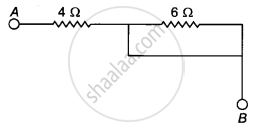Advertisements
Advertisements
Question
What is (a) the highest, (b) the lowest total resistance that can be secured by combinations of four coils of resistance 4 Ω, 8 Ω, 12 Ω, 24 Ω?
Solution
There are four coils of resistances: 4 Ω, 8 Ω, 12 Ω and 24 Ω, respectively.
(a) If these coils are connected in series, then the equivalent resistance will be the highest, given by the sum 4 + 8 + 12 + 24 = 48 Ω
(b) If these coils are connected in parallel, then the equivalent resistance will be the lowest, given by,
`1/(1/4+1/8+1/12+1/24)=1/((6+3+2+1)/24)=24/12=2 Omega`
Therefore, 2 Ω is the lowest total resistance.
APPEARS IN
RELATED QUESTIONS
Why are copper and aluminium wires usually employed for electricity transmission?
Why are alloys commonly used in electrical heating devices? Give reason.
What is meant by conductors and insulators? Give two examples of conductors and two of insulators.
What is the general name of the substances having infinitely high electrical resistance?
Classify the following into good conductors, resistors and insulators:
Rubber, Mercury, Nichrome, Polythene, Aluminium, Wood, Manganin, Bakelite, Iron, Paper, Thermocol, Metal coin
What do you understand by the "resistivity" of a substance?
Give two examples of substances which are good conductors of electricity. Why do you think they are good conductors of electricity?
Calculate the resistance of a copper wire 1.0 km long and 0.50 mm diameter if the resistivity of copper is 1.7 × 10−8 Ω m.
How does the resistance of a conductor depend on:
length of the conductor?
How does the resistance of a conductor depend on:
area of cross-section of the conductor?
How does the resistance of a conductor depend on:
temperature of the conductor?
What would be the effect on the resistance of a metal wire of:
increasing its length?
How does the resistance of a wire change when:
its material is changed to one whose resistivity is three times?
How will you infer with the help of an experiment that the same current flows through every part of the circuit containing three resistors R1, R2 and R3 in series connected to a battery of V volts?
The effective resistance between A and B is:

Use the data in the Table given below to answer the following –
Which material is the best conductor?
Table give below Electrical resistivity of some substances at 20°C
| Electrical resistivity of some substances at 20°C | ||
| − | Material | Resistivity (Ω m) |
| Conductors |
Silver | 1.60 × 10−8 |
| Copper | 1.62 × 10−8 | |
| Aluminium | 2.63 × 10−8 | |
| Tungsten | 5.20 × 10−8 | |
| Nickel | 6.84 × 10−8 | |
| Iron | 10.0 × 10−8 | |
| Chromium | 12.9 × 10−8 | |
| Mercury | 94.0 × 10−8 | |
| Manganese | 1.84 × 10−6 | |
| Alloys |
Constantan (alloy of Cu and Ni) |
49 × 10−6 |
| Manganin (alloy of Cu, Mn and Ni) |
44 × 10−6 | |
| Nichrome (alloy of Ni, Cr, Mn and Fe) |
100 × 10−6 | |
| Insulators | Glass | 1010 − 1014 |
| Hard rubber | 1013 − 1016 | |
| Ebonite | 1015 − 1017 | |
| Diamond | 1012 − 1013 | |
| Paper (dry) | 1012 | |
How will you infer with the help of an experiment that the same current flows through every part of the circuit containing three resistances in series connected to a battery?
The resistance of a wire of 0.01 cm radius is 10 Ω. If the resistivity of the wire is 50 × 10-8 Ω, find the length of this wire.
